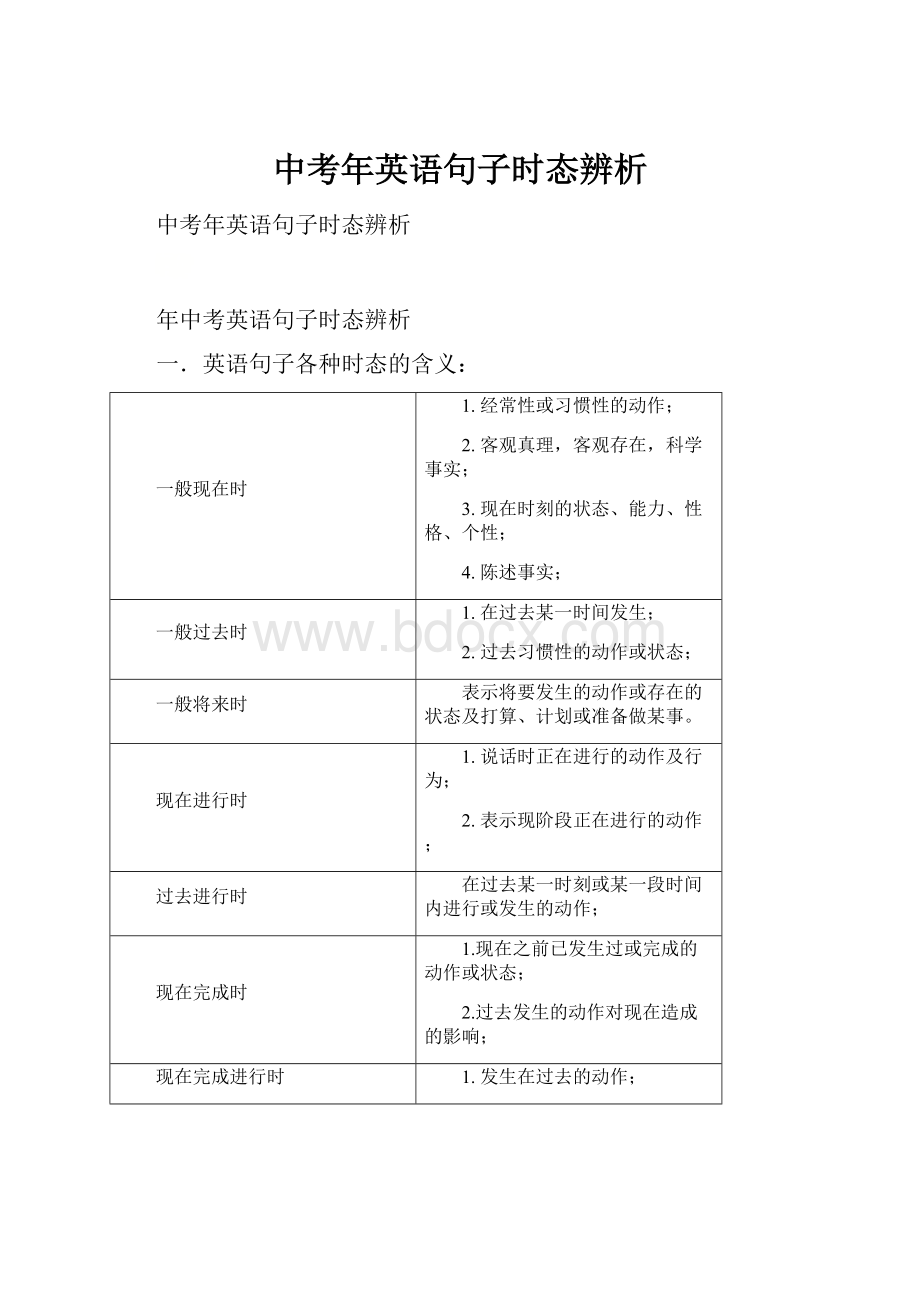中考年英语句子时态辨析.docx
《中考年英语句子时态辨析.docx》由会员分享,可在线阅读,更多相关《中考年英语句子时态辨析.docx(32页珍藏版)》请在冰豆网上搜索。

中考年英语句子时态辨析
中考年英语句子时态辨析
年中考英语句子时态辨析
一.英语句子各种时态的含义:
一般现在时
1.经常性或习惯性的动作;
2.客观真理,客观存在,科学事实;
3.现在时刻的状态、能力、性格、个性;
4.陈述事实;
一般过去时
1.在过去某一时间发生;
2.过去习惯性的动作或状态;
一般将来时
表示将要发生的动作或存在的状态及打算、计划或准备做某事。
现在进行时
1.说话时正在进行的动作及行为;
2.表示现阶段正在进行的动作;
过去进行时
在过去某一时刻或某一段时间内进行或发生的动作;
现在完成时
1.现在之前已发生过或完成的动作或状态;
2.过去发生的动作对现在造成的影响;
现在完成进行时
1.发生在过去的动作;
2.过去发生的动作一直持续到现在,中间没有间断,还可能持续下去;
3.过去发生的动作对现在造成影响;
过去完成时
1.以过去某个时间为标准,在此以前发生的动作或行为;
2.在过去某动作之前完成的行为,即“过去的过去”;
过去将来时
指对过去的某一个时间来讲,将要发生的动作;
二.英语句子各种时态的时间状语:
一般现在时
1.every+day/morning/Wednesday/week/spring/month/year….
2.often,always,usually,sometimes….
3.onweekends,onSundays等等
一般过去时
1.yesterday,thedaybeforeyesterday,amomentago,justnow;
2.last+night/week/month/year…
3.anhour/threedays/fiveyearsago;
4.in+过去的某一年;
一般将来时
1.tomorrow,thedayaftertomorrow,thisafternoon/evening,inthefuture;
2.in+将来的某一年;
3.next+week/month/year/autumn….
现在进行时
now、look,、listen、atthemoment、It’s+时间点….;
过去进行时
1.atthattime、atthatmoment;
2.atthistimeofyesterday、atninelastnight…
3.与when,while,as引导的过去时间状语连用;
现在完成时
1.since+过去的时间点;2.for+一段时间;
3.already,even,yet,before,just,never,foralongtime,sofar等;
现在完成进行时
1.yet,already,just…;2.for,since;
过去完成时
bythen(截止到那时);by9o’clock(直到九点钟)
bytheendof…(在…结束/末之前);bythetime…(在…时之前);uptillthen直到那时;upuntillastnight(直到昨晚)
2.before等介词短语或一个时间状语从句来表示;
过去将来时
没有什么标志词,通常用在从句里;
如:
HelensaidthatshewouldleaveforAmericatomorrow.
三.英语句子各种时态的句子结构:
一般现在时
第一类:
含be动词的句子,动词用am,is,are的形式:
肯定句:
主语+be(am,is,are)+其他.
否定句:
主语+amnot/isn’t/aren’t+其他.
一般疑问句:
Am/Is/Are+主语+其他?
肯否定回答:
Yes,主语+am/is/are.
No,主语+amnot/isn’t/aren’t.
特殊疑问句:
特殊疑问词+am/is/are+主语+其它?
第二类.含行为动词的句子:
第一种:
当主语为第一人称,第二人称和第三人称的复数时
肯定句:
主语+动词原形+其他.
否定句:
主语+don’t+动词原形+其他.
一般疑问句:
Do+主语+动词原形+其他?
肯否定回答:
Yes,主语+do.No,主语+don’t.
特殊疑问句:
特殊疑问词+do+主语+动词原形+其它?
第二种:
当主语为第三人称的单数时
肯定句:
主语+动词的第三单+其他.
否定句:
主语+doesn’t+动词原形+其他.
一般疑问句:
Does+主语+动词原形+其他?
肯否定回答:
Yes,主语+does.No,主语+doesn’t.
特殊疑问句:
特殊疑问词+does+主语+动词原形+其它?
一般过去时
第一类:
含be动词的句子,动词用was,were的形式:
肯定句:
主语+was/were+其他.
否定句:
主语+wasn’t/weren’t+其他.
一般疑问句:
Was/Were+主语+其他?
肯否定回答:
Yes,主语+was/were.
No,主语+wasn’t/weren’t.
特殊疑问句:
特殊疑问词+was/were+主语+其它?
第二类.含行为动词的句子:
肯定句:
主语+动词的过去式+其它.
否定句:
主语+didn’t+动词原形+其它.
一般疑问句:
Did+主语+动词原形+其它?
肯定回答:
Yes,主语+did.
否定回答:
No,主语+didn’t.
特殊疑问句:
特殊疑问词+did+主语+动词原形+其它?
一般将来时
第一种:
be(am,is,are)+动词的ing形式;
第二种:
begoingto+动词的原形。
第三种:
will/shall+动词的原形。
(shall适合第一人称:
Iwe;will适合任何人称)
肯定句:
主语+will/shall+动词原形+其他.
否定句:
主语+won’t+动词原形+其他.
一般疑问句:
Will+主语+动词原形+其他?
肯否定回答:
Yes,主语+will.No,主语+won’t.
特殊疑问句:
特殊疑问词+will+主语+动词原形+其它?
现在进行时
肯定句:
主语+be(am,is,are)+动词的现在分词+其他.
否定句:
主语+amnot/isn’t/aren’t+doing+其他.
一般疑问句:
Am/Is/Are+主语+doing+其他?
肯否定回答:
Yes,主语+am/is/are.
No,主语+amnot/isn’t/aren’t.
特殊疑问句:
特殊疑问词+am/is/are+主语+doing+其它?
过去进行时
肯定句:
主语+was/were+doing+其他.
否定句:
主语+wasn’t/weren’t+doing+其他.
一般疑问句:
Was/Were+主语+doing+其他?
肯否定回答:
Yes,主语+was/were.
No,主语+wasn’t/weren’t.
特殊疑问句:
特殊疑问词+was/were+主语+doing+其它?
现在完成时
肯定句:
主语+have/has+动词的过去分词+其他.
否定句:
主语+haven’t/hasn’t+动词的过去分词+其他.
一般疑问句:
Have/Has+主语+动词的过去分词+其他?
肯定回答:
Yes,主语+have/has.
否定回答:
No,主语+haven’t/hasn’t.
特殊疑问句:
特殊疑问词+一般疑问句?
特殊疑问词+have/has+主语+动词的过去分词+其他?
现在完成进行时
肯定句:
主语+have/has+been+v.ing+其他.
否定句:
主语+haven’t或hasn’t+been+v.ing+其他.
一般疑问句:
Have/Has+主语+been+v.ing+其他?
肯定回答:
Yes,主语+have/has.
否定回答:
No,主语+haven’t/hasn’t.
特殊疑问句:
特殊疑问词+have/has+主语+been+v.ing+其他?
过去完成时
肯定句:
主语+had+动词的过去分词+其他.
否定句:
主语+hadn’t+动词的过去分词+其他.
一般疑问句:
Had+主语+动词的过去分词+其他?
肯定回答:
Yes,主语+had.否定回答:
No,主语+hadn’t.
特殊疑问句:
特殊疑问词+一般疑问句?
特殊疑问词+have/has+主语+动词的过去分词+其他?
过去将来时
肯定句:
主语+would+动词原形+其他.
否定句:
主语+wouldn’t+动词原形+其他.
特别注意:
短暂性动词在肯定句、疑问句中不能与时间段连用,需换为:
become→be
begin→have
buy→have
borrow→keep
finish→beover
leave→beaway(from…)
die→bedead
join→bein…(beamemberof…)
come(go,arrive,get)→behere/there/in…
如:
Ihaveboughtthiswatchforfiveyears.→Ihavehadthiswatchforfiveyears.
Theoldmanhasdiedfortenyears.→Theoldmanhasbeendeadfortenyears.
Ihavelefthometownfor10years.→Ihavebeenawayfromhometownfor10years.
Hehascomebackfor3days.→Hehasbeenbackfor3days/since3daysago.
Thefilmhasbegunfor5minutes.→Thefilmhasbeenonfor5minutes.
HisfatherhasjoinedthePartysince1950.→HisfatherhasbeeninthePartysince1950.
四.英语句子各种时态中动词的变化形式:
一般现在时
动词的第三人称单数的变化规则
1.一般情况下,直接在动词末尾+s;
2.以s,sh,x,ch,和部分以o结尾的+es;
3.以辅音字母+y结尾的,变y为i,再加es;
4.一个不规则变化:
have---has
一般过去时
动词过去式的变化规则
1.一般情况下,直接在动词末尾+ed;
2.以不发音的元音字母e结尾的动词,在动词末尾+d;
3.以辅音字母+y结尾的,变y为i,再加ed;
4.重读闭音节动词,要双写最后一个辅音字母,再加ed;
5.不规则变化---见后面的不规则动词表;
一般将来时
动词用原形;如果用正在进行时表将来,动词变为现在分词;
现在进行时
动词的现在分词的变化规则
1.一般情况下,直接在动词末尾+ing:
2.以不发音的元音字母e结尾的动词,要去e再加ing:
3.重读闭音节动词,要双写最后一个辅音字母,再加ing:
4.两个不规则变化:
lie--lyingdie—dying
过去进行时
动词变为现在分词;
现在完成时
动词过去分词的变化规则
1.一般情况下,直接在动词末尾+ed;
2.以不发音的元音字母e结尾的动词,在动词末尾+d;
3.以辅音字母+y结尾的,变y为i,再加ed;
4.重读闭音节动词,要双写最后一个辅音字母,再加ed;
现在完成进行时
动词变为现在分词;
过去完成时
动词变为过去分词;
过去将来时
动词用原形;
五.动词过去式,过去分词的不规则变化表:
一、AAA型(原形→原形→原形)
原形
过去式
过去分词
汉语意思
read
read
read
读
cut
cut
cut
切,割
let
let
let
让
put
put
put
放
cost
cost
cost
花费,值
hit
hit
hit
撞,击
set
set
set
安排,安置
hurt
hurt
hurt
使…伤痛
二、ABA型(原形→过去式→原形)
原形
过去式
过去分词
汉语意思
become
became
become
成为
come
came
come
来
run
ran
run
跑
三、ABC型1.ow→ew→own
原形
过去式
过去分词
汉语意思
blow
blew
blown
吹
draw
drew
drawn
画
grow
grew
grown
生长
know
knew
known
知道
fly
flew
flown
飞
2.i→a→u
原形
过去式
过去分词
汉语意思
begin
began
begun
开始
drink
drank
drunk
喝
sing
sang
sung
唱
swim
swam
swum
游泳
ring
rang
rung
打电话
3.原形→过去式→过去式+(e)n
原形
过去式
过去分词
汉语意思
wear
wore
worn
穿
forget
forgot
forgotten
忘记
speak
spoke
spoken
说
freeze
froze
frozen
冻
choose
chose
chosen
选择
4.原形→过去式→原形+(e)n
原形
过去式
过去分词
汉语意思
eat
ate
eaten
吃
forbid
forbade
forbidden
禁止
give
gave
given
给
ride
rode
ridden
骑
see
saw
seen
看见
write
wrote
written
写
fall
fell
fallen
落下
5.无规律
原形
过去式
过去分词
汉语意思
am/is
was
been
是
are
were
been
是
do
did
done
做
go
went
gone
走
take
took
taken
拿
四、ABB型1.原形→ought→ought
原形
过去式
过去分词
汉语意思
bring
brought
brought
带来
buy
bought
bought
买
fight
fought
fought
打架
think
thought
thought
思考
2.原形→aught→aught
原形
过去式
过去分词
汉语意思
catch
caught
caught
捉,抓
teach
taught
taught
教
3.变其中一个元音字母
原形
过去式
过去分词
汉语意思
feed
fed
fed
喂
meet
met
met
遇见
get
got
got
得到
hold
held
held
拥有
babysit
babysat
babysat
临时照看
sit
sat
sat
坐
win
won
won
赢
find
found
found
发现
4.原形→□lt→□lt
原形
过去式
过去分词
汉语意思
feel
felt
felt
感到
keep
kept
kept
保持
leave
left
left
离开
sleep
slept
slept
睡
sweep
swept
swept
扫
5.变其中一个辅音字母
原形
过去式
过去分词
汉语意思
build
built
built
建造
hear
heard
heard
听见
make
made
made
制造
mean
meant
meant
意思
send
sent
sent
送,寄
spend
spent
spent
花费
deal
dealt
dealt
处理
6.辅音字母和元音字母都变
原形
过去式
过去分词
汉语意思
have
had
had
有,吃
lay
lain
lain
放
lose
lost
lost
丢失
pay
paid
paid
付钱
say
said
said
说
sell
sold
sold
卖
tell
told
told
告诉
stand
stood
stood
站
五、AAB型
原形
过去式
过去分词
汉语意思
beat
beat
beaten
打败
六、有两种形式
原形
过去式
过去分词
汉语意思
bear
bore
born
生
bore
borne
hang
hanged
hanged
吊死
hung
hung
挂
learn
learned
learned
学
learnt
learnt
lie
lied
lied
说谎
lay
lain
躺
show
showed
showed
给…看
showed
shown
spell
spelled
spelled
拼写
spelt
spelt
burn
burned
burned
烧
burnt
burnt
smell
smelled
smelled
闻
smelt
smelt
shine
shined
shined
照耀
shone
shone
dream
dreamed
dreamed
做梦
dreamt
dreamt
wake
waked
waked
醒
woke
woken
hide
hid
hid
躲藏
hid
hidden
七、情态动词
原形
过去式
过去分词
汉语意思
can
could
∕
能
may
might
∕
也许
must
∕
∕
必须
shall
should
∕
将要
will
would
∕
会
常见的系动词
第一种:
状态系动词----表示主语状态,只有be一词;
第二种:
持续系动词---表示主语继续或保持一种状况或态度:
keep,rest,stay,lie,stand;
第三种:
表像系动词--用来表示"看起来像"这一概念,主要有seem,appear,look;
第四种:
感官系动词---感官系动词主要有feel,smell,sound,taste;
第五种:
变化系动词----表示主语变成什么样,主要有become,grow,turn,fall,get,go,come;
第一类带“to”结构:
动词+sb.sth.=动词+sth.tosb.
1)givesth.tosb.=givesb.sth.
给某人某物
2)showsth.tosb.=showsb.sth.
把…给某人看
3)passsth.tosb.=passsb.sth.
把…递给某人
4)sendsth.tosb.=sendsb.sth.
把某物送给某人,邮寄某物给某人
5)sellsth.tosb.=sellsb.sth.
卖某物给某人
6)teachsth.tosb.=teachsb.sth.
教某人做某事
7)offersth.tosb.=offersb.sth.
为某人提供某物
8)bringsb.sth.=bringsth.tosb.
把某物带给某人
9)handsb.sth.=handsth.tosb.
把某物递给某人
10)lendsb.sth.=lendsth.tosb.
把某物借给某人
11)mailsb.sth.=mailsth.tosb.
把某物寄给某人
12)owesb.sth.=owesth.tosb.
欠某人某物
13)paysb.sth.=paysth.tosb.
付给某人某物(钱)
14)postsb.sth.=poststh.tosb.
把某物寄给某人
15)readsb.sth.=readsth.tosb.
把某物读给某人听
16)returnsb.sth.=returnsth.tosb.
把某物还给某人
17)servesb.sth.=servesth.tosb.
拿某物招待某人
18)takesb.sth.=takesth.tosb.
把某物拿给某人
19)tellsb.sth.=tellsth.tosb.
告诉某人某情况
20)throwsb.sth.=throwsth.tosb.
把某物扔给某人
21)providesth.tosb.=providesb.withsth.
为某人提供某物
第二类带“for”结构:
动词+sb,sth.=动词+sth.forsb.
1)buysth.forsb.=buysb.sth.
买某物给某人
2)makesth.forsb.=makesb.sth.
为某人制作某物
3)cooksth.forsb.=cooksb.sth.
为某人做饭
4)